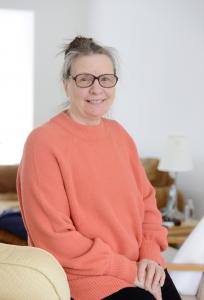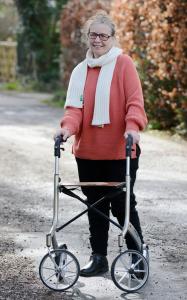Ataxia UK
Beryl Park, 69, from Northumberland, explains how Ataxia UK has supported her through the challenges she faces living with cerebellar ataxia
Beryl Park first became concerned about her health in the mid-1990s when she noticed several unusual symptoms. “If I did an exercise class, I couldn’t follow what everyone was doing as I’d struggle with coordination, and I would often lose my balance altogether. I had also started to have regular déjà vu episodes, which was really strange.”
Beryl went to her GP, who was at a loss as to what was wrong. “Then, one night in 1997, I was driving and lost control of my car, which slid downhill on ice. Later that night, I had a seizure in my sleep and woke up in hospital, which was very frightening. Because of the seizure and my déjà vu, I was diagnosed with temporal lobe epilepsy – which causes seizures starting in or involving one or both temporal lobes in the brain.”
Over the next few years, Beryl was back and forth to the GP as more symptoms not associated with epilepsy crept in. “I had double vision and nystagmus (or ‘dancing eyes’) – a condition in which the eyes make repetitive, involuntary movements up and down, side to side or in a circle. Despite all my symptoms, I felt like I was being classed as a time-waster and my visits were being put down to depression.”
In 2011, Beryl started having regular falls, so was sent to the Falls and Syncope Clinic. “My GP said he would usually just send elderly people to this service, but he didn’t know what to do with me so would give it a shot. I was given a variety of tests including a tilt table test, after which I could barely stand. I felt completely drunk and had to be supported by two of the nurses.”
“Many of the symptoms are hidden so it’s easy for someone to assume I’m ok, but Ataxia is challenging to deal with”
Following this, she was sent for an MRI scan, which confirmed Beryl had cerebellar atrophy – a degeneration of the area of the brain that controls coordination and balance. She was diagnosed with idiopathic cerebellar ataxia, a form of ataxia (a group of disorders affecting coordination, balance and speech) of unknown cause, which gets slowly worse over time.
“In one way it was a relief to feel I wasn’t going completely mad and finally someone believed there was something wrong, but it was also scary,” recalls Beryl. “I remember seeing people coming out from the neurologist on crutches and in wheelchairs barely able to walk, and thinking, ‘What on earth does this mean for me?’ “The neurologist explained that although my condition is not terminal it would be life-changing. There was a high probability I would end up having to use a wheelchair, which was difficult to come to terms with.”
Beryl eventually had to give up work in the family business, as she had difficulties with her concentration and multitasking. She also progressed to using a walking stick or rollator outdoors as her balance became worse and her perception of depth and spatial awareness was affected. “It was a big thing to go on to using a walking stick, but safety had to be paramount and it’s so easy for me just to fall off a kerb or lose my balance if the surface isn’t level.
“I also now have difficulty writing legibly, slur my speech, and no longer enjoy social occasions. It’s hard to relax when you know your concentration is likely to wander because multitasking (keeping balanced, focusing on your surroundings, and paying attention to conversation) is so exhausting. Even day-to-day shopping can be stressful as fluorescent lighting, subdued lighting and busy areas can be overwhelming. My memory and emotions can also be really affected. Many of the symptoms of this condition are hidden, so it’s easy for someone to assume you’re doing OK, but it can be extremely challenging to deal with.”
“The peer group meetings give people the opportunity to vent their feelings, have a few laughs, and talk to others who understand what you’re going through”
Fortunately, Beryl has had the support of Ataxia UK. “When I was diagnosed, I knew nothing about the condition, so was very grateful for the booklet sent to me by Ataxia UK, which really helped me to understand it.
“I also attend a monthly peer support group, which was originally set up by the Newcastle Ataxia Centre. It is a great source of support and gives people the opportunity to vent their feelings, have a few laughs, and talk to others who understand what you’re going through, as you don’t always want to tell your family and friends how difficult it all is.”
Ataxia UK raised money in The Candis Big Give to go towards establishing additional NHS-accredited ataxia centres (of which there are only two in the UK), improving access to specialist services at all centres, and establishing virtual clinics where patients can be seen by expert ataxia neurologists by video link, reducing the need to travel. “My local ataxia centre closed several years ago so now I am being seen by a specialist neurologist more than 300 miles away at the London Ataxia Centre, but I’d love to see another one open in my area. Having more local centres and virtual clinics is very important, as GPs don’t always know that much about the condition, with it being so rare, and it’s important to have easy access to a specialist who understands what you’re going through.
“The charity is incredibly knowledgeable and informative and without it I wouldn’t have known where to turn or what to do following my diagnosis. I was given the information and support that I needed, right at the time when I needed it, which is what these centres are all about.”
Improving access to diagnosis and treatment
TOTAL RAISED: £78,472
The money raised in The Candis Big Give will help Ataxia UK to improve access to diagnosis and treatment for the 12,000 people across the UK living with a form of ataxia – rare, life-limiting, progressively destructive conditions for which there is currently no cure. The money will go towards establishing more NHS-accredited ataxia centres and improving access to extended specialist services at all centres with the provision of Multidisciplinary Community Teams, a peer support scheme at all centres, and virtual clinics where patients can be seen by expert ataxia neurologists by video link, reducing the need to travel.
Visit ataxia.org.uk to find out more.
Donations to date
We never forget it’s YOUR subscriptions that enable Candis Club to give huge amounts to charities. Our running total shows how much
£31,620,386 to the Cancer and Polio Research Fund (1962 to 2002)
£4,429,597 to the National Asthma Campaign (1990 to 2002)
£5,500,979 to Marie Curie (1998 to 2012)
£3,304,767 to Macmillan Cancer Support (1993 to 2013)
£3,309,982 to Bliss, the special care baby charity (1990 to 2009)
£2,190,977 to Liverpool University’s Cancer Tissue Bank Research Centre (1989 to 1993)
£1,549,998 to the British Heart Foundation (2002 to 2008)
£914,053 to local groups via the Charities Aid Foundation (CAF) (1990 to 2009)
£220,000 to ICAN (1989)
£246,876 to Tommy’s, the baby charity (2006 to 2009)
£303,774 to Children’s Hospices UK (2008 to 2010)
£2,500,000 to charities in The Candis Big Give
TOTAL TO DATE
£56,091,389
In 2020, Candis Club will donate at least £250,000 from members’ magazine subscription revenue to health charities taking part in The Candis Big Give. Any additional funds will go to charities at the discretion of the General Committee of Candis Club
Make a difference
We’ve highlighted some of the charities taking part in The Candis Big Give. For a full list, and details of the life-changing projects they’re raising money for, visit candis.co.uk/charity
Action for ME
What it does: Raises awareness of ME and ensures those affected by it get the care and support they need.
Candis Big Give project: Money raised will support people affected by ME and research into the condition.
Location: National
Total raised: £129,736
Canine Partners
What it does: Partners people with disabilities with assistance dogs.
Candis Big Give project: To provide disabled adults with assistance dogs.
Location: National
Total raised: £102,668
Joss Searchlight
What it does: Supports families affected by childhood cancer.
Candis Big Give project: The money will go towards an art project involving more than 300 children.
Location: Oxfordshire
Total raised: £8,995
Maggie’s Centres
What it does:
Supports people
with cancer and their families and friends.
Candis Big Give project: To continue to offer a wide range of services to those affected by cancer.
Location: London
Total raised: £22,532
Rays of Sunshine Children’s Charity
What it does: Supports seriously ill children and their families.
Candis Big Give project: To create precious memories at Christmas.
Location: National
Total raised: £11,945
Ruddi’s Retreat
What it does: Gives families with ill children access to a holiday home.
Candis Big Give project: To give ill children and their families a holiday.
Location: Yorkshire
Total raised: £4,768
Sebastian’s Action Trust
What it does: Offers support and holidays to seriously ill children.
Candis Big Give project: To provide families of ill children with support.
Location: Berkshire and Hampshire
Total raised: £25,677
How Buying a Subscription Helps – In 2020, Candis Club will donate at least £250,000 from members’ magazine subscription revenue to health charities taking part in The Candis Big Give.
Any additional funds will go tocharities at the discretion of the General Committee of Candis Club.



Leave a Reply
Please login or register to leave a comment.